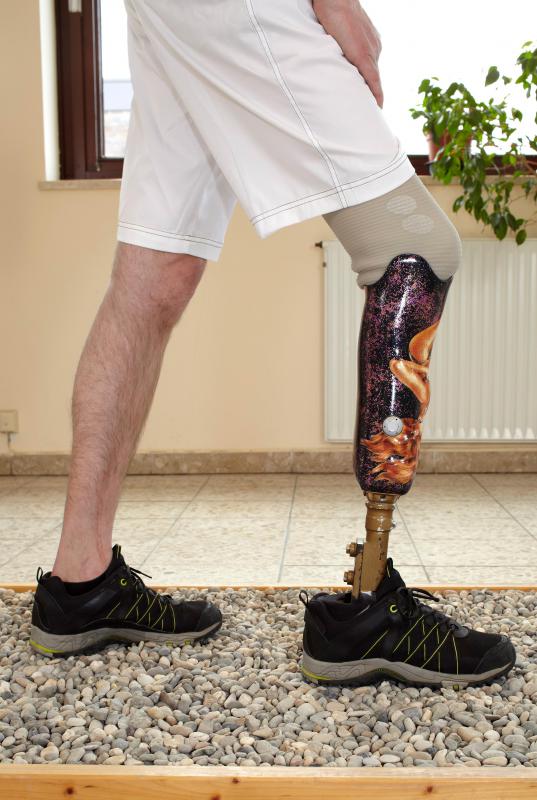At WiseGEEK, we're committed to delivering accurate, trustworthy information. Our expert-authored content is rigorously fact-checked and sourced from credible authorities. Discover how we uphold the highest standards in providing you with reliable knowledge.
What Is a Prosthetic Running Leg?
A prosthetic running leg is a device used by disabled athletes who have lost the lower part of a leg. This device allows the athlete to run normally, even with part of the leg missing. The prosthesis is J-shaped, and usually made from carbon fiber. The leg itself fits into a harness or cage that wraps tightly around the remaining part of the leg that has been amputated, and the runner is therefore able to fit the device snugly to the leg for use.
The carbon fiber that comprises the prosthetic running leg will flex enough to absorb the shock of the body coming down toward the ground, but it is rigid enough to keep from snapping or otherwise bending too far during normal use. The device allows a runner to complete a normal running stride without the use of an entire leg; the prosthetic running leg is only suitable for amputees whose legs have been removed below the knee, however, as the flex of the knee is still required for a normal running stride. The carbon fiber will create some propulsion forward as well, meaning the device helps push the body forward just as the human foot would do.

Double amputees can also use a prosthetic running leg; one prosthetic will be fitted onto each leg, allowing the person to run normally despite the absence of lower legs The runner will be able to balance and pivot, which makes upright movement possible. Some critics of the device have argued that the prosthetic running leg affords a disabled runner an unfair advantage over athletes with legs. Arguments have been made that the disabled runner will expend less energy overall during the running process than someone running without the prosthetics, but such complaints have not been proven to be true or false.

Some people also argue that the amputee's running stride will be further helped because the J-shape of the prosthetic running leg will prevent excess upward movement common in the normal human running stride. In other words, opponents argue disabled runners have a mechanical advantage over other runners, and they should therefore not compete in the same category. Recreational runners are not affected by this argument, and these points will actually be considered advantages by most runners; less excess movement means less expended energy, which can translate into more efficient training and longer runs.
AS FEATURED ON:
AS FEATURED ON:












Discussion Comments
I watched the runner in the Olympics who had the prosthetic legs. I thought it was great that he was able to compete considering what he had been through. However, I have to admit that when I saw him doing so well I couldn't help but wonder whether the good results had more to do with the man or the running prosthetic legs.
@Drentel - I am not a former athlete-- not even close. So maybe this has something to do with the way I feel. I say anyone who thinks that having a prosthetic leg gives a person an unfair advantage in sports should walk in the shoes of the person with the prosthetic leg. I bet you no one is going to readily change places with a double amputee because he or she thinks the double amputee can run faster with the prosthetic legs.
As a former athlete, I understand the argument of people who are concerned that certain prosthetic legs might give the athletes wearing them an advantage. We all know the way science works and how technology can improve the way things work, including body parts.
I know the show about the bionic man was fiction, but I think scientists have the ability to create bionic body parts that are stronger than the body parts they are replacing.
I don't know if athletes using prosthetic limbs should be limited to competing against other athletes with prosthetic limbs, but I do think the powers that be need to make sure that the playing field is level for everyone.
Post your comments